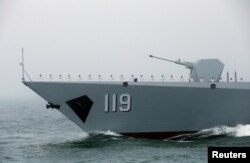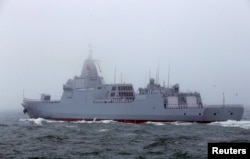China's two decades of military modernization has paid off big in missile development and domains like cyber and space, but the Pentagon says China is still relying on spying on others to steal the latest military technology.
"China uses a variety of methods to acquire foreign military and dual-use technologies, including targeted foreign direct investment, cyber theft, and exploitation of private Chinese nationals' access to these technologies, as well as ... computer intrusions and other illicit approaches," according to a congressionally mandated Pentagon report released Thursday.
Randall Schriver, the assistant secretary of defense for Indo-Pacific security affairs, told reporters Friday at the Pentagon that China frequently uses tactics that fall just short of armed conflict to reach its goal of becoming a "world-class military by 2049," from threats and coercion against media and academia to jamming systems against ships in international waters in the South China Sea.
The report said China has used these illicit approaches to acquire military-grade technologies from the United States that ranged from antisubmarine to aviation equipment.
He said the Chinese were "very aggressive" with modernization and had made "significant progress" in their ballistic and cruise missile development, but he stopped short of calling Beijing an adversary.
"We certainly don't see conflict with China, and it doesn't preclude cooperation where interests align," Schriver told reporters.
Arctic
The report also shows increased Chinese activities in the Arctic region.
Arctic states have expressed concerns that Beijing could use its presence there to strengthen China's military reach, mirroring worries about Chinese military presence in Africa and Latin America following its Belt and Road economic initiative.
"Civilian research could support a strengthened Chinese military presence in the Arctic Ocean, which could include deploying submarines to the region as a deterrent against nuclear attacks," the report notes.
The Pentagon report noted that European allies like Denmark have expressed concern about Chinese proposals to establish a research station and a satellite ground station in Greenland.
Concentration camps
Schriver also noted the U.S. military's concern that the Chinese Communist Party's Central Military Commission has taken sole authority of the People's Armed Police, China's primary force for internal security.
He accused China of imprisoning close to 3 million Chinese Muslims in "concentration camps" that "erode the rules-based order." He later defended his description, which harks back to the Jewish concentration camps in Nazi Germany, as appropriate, given the magnitude of the Chinese detentions and the goals of the camps based on public comments from the Chinese government.


